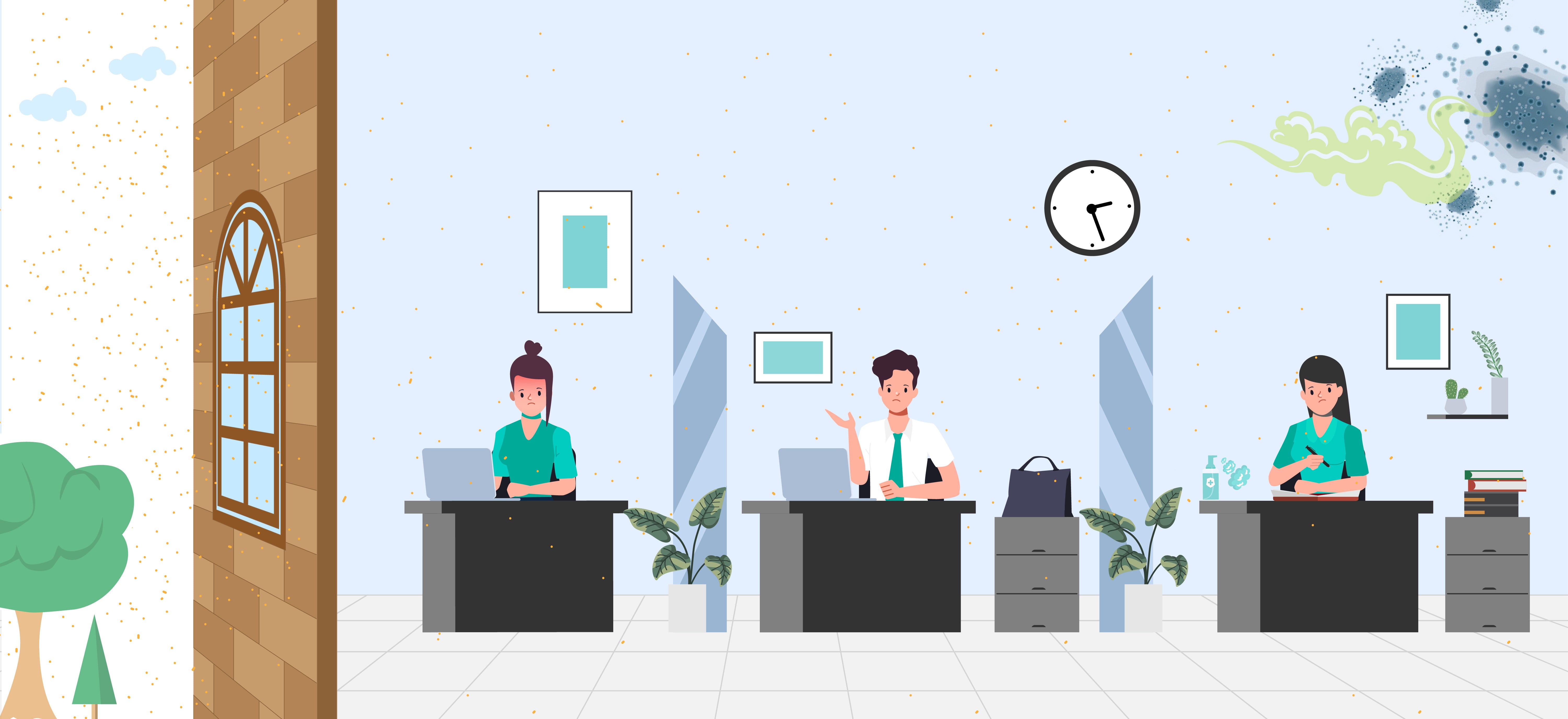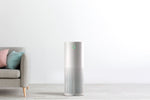Sick Building Syndrome: What it is and How to Prevent it

Written by Brittany German
Over the last few years, Sick Building Syndrome has received more and more attention as workplaces feel sick in the office, but fine away from the office. It can often be mistaken for the flu, or allergies, but when an entire office feels sick at the same time, that's probably Sick Building Syndrome (SBS).
Sick Building Syndrome is the term used to describe the year-round symptoms that employees experience from working in an office with inadequate air quality.
Possible Symptoms:
- breathing difficulties
- tightness in the chest
- allergy-like symptoms
- headaches
- dizziness
- fatigue
- nausea
- body aches
- fever
- chills
Those are just some symptoms, but there are many more. It's sometimes hard to diagnose SBS when it might feel like the seasonal flu, or allergies. The easiest way to diagnose SBS is to track your symptoms in and away from the office. SBS symptoms are most likely to pass when you leave the building and come back when you return. It's also a good idea to visit your doctor when you develop these symptoms. Once you've eliminated other possibilities, you can narrow down the cause; you're likely working in an office with poor air quality.
Sick Building Syndrome can make going into work everyday a struggle. Luckily, there are many solutions for healthier workspaces, but first, it's important to peg the causes and the culprits so that you know how to best go about solving it.
Why Offices Experience Sick Building Syndrome
Working in an office means you're probably working in close proximity to others and using shared spaces like lounges or kitchens. Biological and chemical air contaminants can transmit through the air or on surfaces and carry diseases that can easily be passed on when working closely with others.
How Far Does A Cough Travel?
Airborne diseases thrive in confined spaces and with poor air circulation, offices are most susceptible to SBS. When someone coughs, germs can be spread far and wide when it comes to enclosed spaces.
Droplets in a cough can travel over 2 meters, depending on the environment. Not only is it important to take into account how far a cough travels when working in an office, but it is just as important to recognize that high touch surfaces are super-spreaders for germs.
Possible Causes of Unhealthy Air Quality
There is a wide variety of poor air quality causes:
- buildings with poor ventilation, such as schools, offices, and public spaces
- high levels of dust
- tobacco smoke
- mold or fungus
- formaldehyde
- asbestos
- cleaning product chemicals
- pesticide
- carbon monoxide
- ground-level ozone
- heat or low humidity
- insect or animal droppings
- building décor
An OHS article breaks down the frequency that each of the following contribute to poor air quality cases:

The Energy Crisis
Many of these causes can be traced back to the energy crisis from the 1970s. Offices were built to be as energy efficient as possible. This means increased insulation, building wraps, weather stripping doors, double- and triple-pane windows, and windows that can't open. Since the energy crisis, air circulation in many buildings is minimal, having only 5 cubic feet of air pumped in when it should be 20 cubic feet. The limited air circulation and airtight buildings have employees working in a chemical stew.
Effects of Air Quality on Health
Biological Air Contaminants
Biological air contaminants can be bacteria, mold, mildew, viruses, animal dander, dust mites, cockroaches, radon, and pollen. Many of these contaminants carry bacteria that circulates through an offices air over and over. These germs can cause allergic reactions, asthma or increased asthma attacks, and infectious illnesses, at the worst case, radon can cause lung cancer.
Most of these biological air contaminants come from dusty fabric, damp areas, stagnant water, or improperly maintained air circulation systems. Radon comes from earth and wet stone underneath buildings. Improperly managed biological factors can quickly lead to air contamination.
Chemical Air Contaminants
As for chemical air contaminants, the CDC has highlighted six.
-
Carbon Monoxide
Carbon monoxide can lead to unconsciousness, and death.
-
Lead
Lead can have negative affects on the brain, the central nervous system, blood cells, and the kidneys. At its worst, it can cause convulsions, comas, and death.
-
Nitrogen Oxides
Nitrogen oxides can cause shortness of breath, respiratory illnesses, and lung disease.
-
Ground-Level Ozone
Ground-level ozone can cause difficulty breathing, coughing, scratchy throat, damaged airways, lung diseases, and increased asthma attacks.
-
Particle Pollution
Particle pollution can cause lung cancer.
-
Sulfur Oxides
Sulfur oxides can cause difficulty breathing.
There are many other chemical air contaminants found in and around office spaces. While smoking outside of a building is better than smoking inside the building, second-hand smoke can still make it into the building through air filtration. That second hand smoke can cause lower respiratory tract infections, and lung cancer. Passive environmental tobacco smoke results in 7,500 to 15,000 hospitalizations each year.
Products like paint, varnishes, wax, and cleaning products can cause eye and respiratory tract irritation, headaches, dizziness, visual disorders, and memory impairment.
Formaldehyde from pressed wood, glue, or textiles, can also cause allergy-like symptoms. Some more dangerous contaminants include pesticides, asbestos, organic gases, and respirable particles which after long term exposure, can lead to more serious symptoms and illnesses like damage to the liver, central nervous system, and kidney, as well as risk of mesothelioma, and lung cancer.
Sensitive Groups at Risk Due to Poor Air Quality
Unhealthy air quality for sensitive groups becomes a concern before the average person becomes symptomatic. Poor air quality has an even more adverse affect on sensitive groups which includes, children, people who already suffer from illnesses like asthma, the elderly, low-income groups, minorities, tribes, and indigenous people.
Some people don't have the resources, the environments, or the immune systems necessary to avoid symptoms as long as the average person. The Air Quality Index (AQI) indicates at what levels unhealthy air quality for sensitive groups begins to take affect. Members of sensitive groups experience negative health effects at an AQI value of 101 to 150 while the average person only begins to feel the effects of poor air quality when the AQI value is between 151 and 200. This means even if the majority of people are not symptomatic, the sensitive group can be suffering.

While some air contaminants might not cause any issues for the average person, some can have significant impact on a select few.
Asthmatic people are more likely to suffer from second-hand smoke, or formaldehyde. People with lung or heart diseases are at a greater risk from exposure to ground-level ozone and particle pollution.
Children, infants, and elderly people are especially sensitive to carbon monoxide exposure, lead, and ground-level ozone either because their lungs are still developing, or they no longer have a strong immune system.
Air quality must be addressed before AQI values reach 101. A healthy value is between 0 and 50. A moderate value is between 51 and 100. The key is to address unhealthy air quality for sensitive groups, because in doing that, air quality will improve for all groups.
Air Filtration in Dental Offices
Quality air filtration for dental offices is paramount since many dental procedures generate aerosols. Aerosols can contain harmful viruses and bacteria that can create a sick building, especially since dental procedures can expel those germs far. Without proper air filtration, those germs remain in the offices and travel airborne to other patients and employees. Most dental offices don't have the luxury of waiting for fallow time before continuing their work, and they might not be leveraging air purification methods to purify their air for the health and safety of patients and employees.
Sick building syndrome can be more common in dental offices because of the presence of airborne bacteria and viruses, but there are actionable tasks available.
Dental air purifiers are available specifically for dental offices that need to control aerosols in a timely manner. A dental air purifier can fight back against harmful aerosols and keep the office safe from sick building syndrome.
Preventing Sick Building Syndrome
There are a few approaches you or your business can take to prevent the yearly bout of sick building syndrome. There are day to day solutions, air purifiers, and plants to help clear toxins.
Best Day-to-Day Strategies:
- Perform regular HVAC maintenance,
- Clean up wet or damp areas to prevent mold and mildew,
- Open windows for better air circulation,
- Choose interior materials that won't expel contaminants over time,
- Use cleaning products with low fumes and no fragrance,
- Vacuum regularly to fight dust and dust mites,
- Shoot for a humidity level of 40 to 70 percent,
- Test for mold and/or fungus, and
- Clean regularly.
Products
The simplest product for this problem is installing an air purifier. The Jaspr Pro air purifier uses HEPA filters which captures 99.97% of particles. That much air purification does a lot to create healthy air. The only work involved in using an air purifier is to replace the filters every couple months depending on the susceptibility of contaminated air in your workplace.
Air purifiers provide a hands-off and effective solution to prevent sick building syndrome.

Plants
Believe it or not, there are many plants that offer air purification benefits. Houseplants can absorb harmful toxins, especially when it comes to enclosed office spaces where there is minimal air flow. Plants are natural, homey, and cost-efficient. Different species of plants can do different things so be sure to look into what toxin you want to clear and find a plant that does just that.
Air Purification is Key for a Healthy Office
Sick building syndrome is a yearly pain. There are a lot of contaminants to watch out for, but more importantly there are many solutions. You have options. General maintenance, daily upkeep, plants, and air purifiers, can maintain healthy air quality to keep you, your employees, and your patients happy and safe.
To maintain high-quality air and keep your building, school, or clinic safe from sick building syndrome, get a Jaspr today!
Back to Blog


